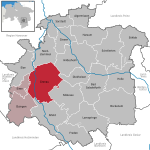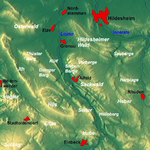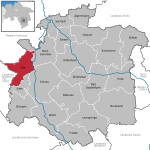Leinebergland (Samtgemeinde)
Hanover region geography stubsSamtgemeinden in Lower Saxony
Leinebergland is a Samtgemeinde ("collective municipality") in the district of Hildesheim, in Lower Saxony, Germany. Its seat is in the town Gronau. It was formed on 1 November 2016 by the merger of the former Samtgemeinden Gronau and Duingen. It takes its name from the Leine Uplands. The Samtgemeinde Leinebergland consists of the following municipalities: Duingen Eime Gronau
Excerpt from the Wikipedia article Leinebergland (Samtgemeinde) (License: CC BY-SA 3.0, Authors).Leinebergland (Samtgemeinde)
Laakedamm, Samtgemeinde Leinebergland
Geographical coordinates (GPS) Address Nearby Places Show on map
Geographical coordinates (GPS)
| Latitude | Longitude |
|---|---|
| N 52.07 ° | E 9.78 ° |
Address
Modellflugplatz am Wallenstedter Teich
Laakedamm
31028 Samtgemeinde Leinebergland
Lower Saxony, Germany
Open on Google Maps


